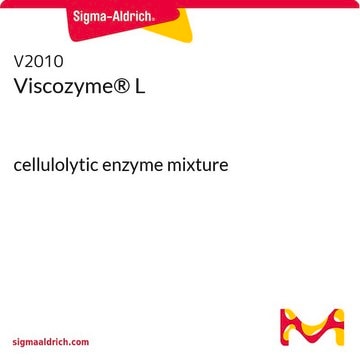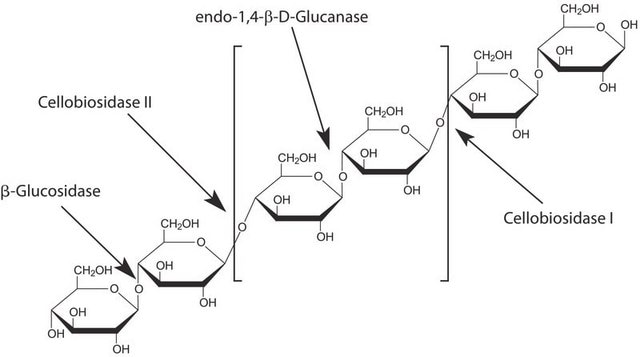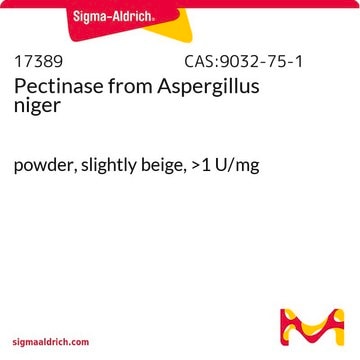The product is offered on the basis of activity. The purity has not been determined.
C1184
Cellulase from Aspergillus niger
powder, ≥0.3 units/mg solid
Synonym(s):
1,4-(1,3:1,4)-β-D-Glucan 4-glucanohydrolase
About This Item
Recommended Products
form
powder
Quality Level
specific activity
≥0.3 units/mg solid
greener alternative product characteristics
Design for Energy Efficiency
Learn more about the Principles of Green Chemistry.
sustainability
Greener Alternative Product
greener alternative category
, Enabling
storage temp.
2-8°C
Looking for similar products? Visit Product Comparison Guide
General description
Cellulase belongs to the family of glycoside hydrolase,[1] which is secreted by various cellulolytic microorganisms.[2]
Application
Biochem/physiol Actions
Unit Definition
Other Notes
substrate
Signal Word
Danger
Hazard Statements
Precautionary Statements
Hazard Classifications
Resp. Sens. 1
Storage Class Code
11 - Combustible Solids
WGK
WGK 1
Flash Point(F)
Not applicable
Flash Point(C)
Not applicable
Personal Protective Equipment
Choose from one of the most recent versions:
Certificates of Analysis (COA)
Don't see the Right Version?
If you require a particular version, you can look up a specific certificate by the Lot or Batch number.
Already Own This Product?
Find documentation for the products that you have recently purchased in the Document Library.
Customers Also Viewed
Protocols
To standardize an enzymatic assay procedure of cellulase.
-
Can you please provide the percent purity of the product?
1 answer-
Helpful?
-
-
Does product C1184 have hemicellulase activity, such as xylanase? I am looking for cellulase without hemicellulase activity.
1 answer-
Hemicellulase activity of this product has not been tested.
Helpful?
-
-
What is the solution stability of Cellulase, Product C1184?
1 answer-
Sigma-Aldrich has not determined the solution stability for this product. However, it is reported in Methods in Enzymology, 160, 264 (1988) that cellulase from Aspergillus niger is "completely stable over the range of pH 5.0-8.0 at 4°C for 24 hours and retains about 50% of its original activity after heating at 70°C for 10 minutes. The enzyme is completely inactivated by heating at 80°C for 10 minutes".
Helpful?
-
-
What is the molecular weight of Product C1184, Cellulase from Aspergillus niger?
1 answer-
The molecular weight is 26,000 Daltons.
Helpful?
-
-
Are there any additives to Cellulase, Product C1184, in addition to the enzyme itself?
1 answer-
Per information from our supplier, maltodextrin is an extender in this product. Maltodextrin can vary in glucose chain lengths of 2-12. There can also be some free glucose in the product. Either sorbitol or propylene glycol is added to the product as a stabilizer during processing. These components may be "flashed off" during processing, but some small amount may still be present.
Helpful?
-
-
What is the Department of Transportation shipping information for this product?
1 answer-
Transportation information can be found in Section 14 of the product's (M)SDS.To access the shipping information for this material, use the link on the product detail page for the product.
Helpful?
-
Active Filters
Our team of scientists has experience in all areas of research including Life Science, Material Science, Chemical Synthesis, Chromatography, Analytical and many others.
Contact Technical Service








